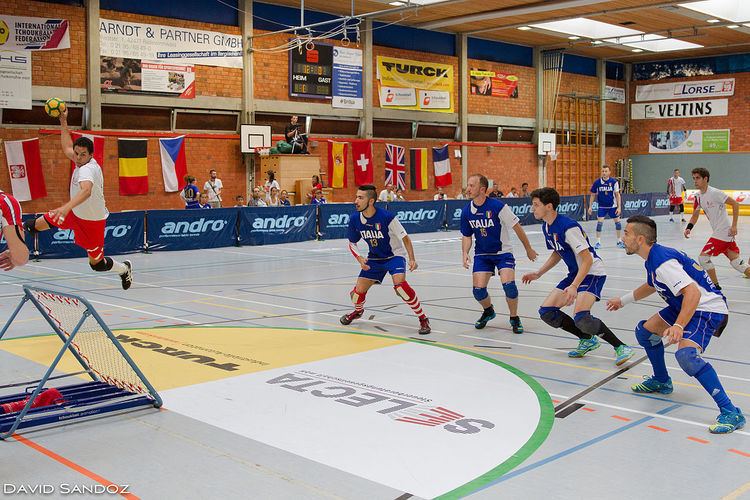First played 1970 Type Ball sport, team sport | Contact No | |
 | ||
Highest governing body Fédération Internationale de Tchoukball (FITB) Team members 7 on Court , 5 Reserve (beach: 5) Mixed gender Not in international championships, but very common in some national championships | ||
Tchoukball /ˈtʃuːkbɔːl/ is an indoor team sport developed in the 1970s by Swiss biologist Hermann Brandt as a warm up activity for the Swiss Handball team.
Contents
- History
- Basic Rules
- Positions
- Playing the game
- International Tchoukball Federation FITB
- Notable Injuries
- Other
- References
The sport is usually played on an indoor court measuring 27 metres by 16 metres. At each end there is a 'frame' (a device similar to a trampoline off which the ball bounces) which measures one square metre and a semicircular D-shaped forbidden zone measuring three metres in radius. Each team can score on both ends on the field, and comprises twelve players, of which seven may be on the court at any one time. In order to score a point, the ball must be thrown by an attacking player, hit the frame and bounce outside the 'D' without being caught by the defending team. Physical contact is prohibited, and defenders may not attempt to intercept the attacking team's passes. Players may take three steps with the ball, hold the ball for a maximum of three seconds, and teams may not pass the ball more than three times before shooting at the frame.
Tchoukball has become an international sport, played in Brazil, Canada, China, the Czech Republic, Great Britain, India, Italy, Japan, Macau, Philippines, Singapore, Switzerland, Taiwan, and the United States. It is governed by the Féderation Internationale de Tchoukball (FITB, founded in 1971). Taiwan hosted the 2004 World Championships and won both the women's and junior championships, with the Swiss men winning the men's championship. The 2006 European Championships were held in Switzerland, with Great Britain taking both the Men's and Under-18's titles, while the hosts won the Women's event.
History
Tchoukball was created in Switzerland by Hermann Brandt, who was concerned by the numerous serious injuries among athletes resulting from sports prone to aggression and physical contact. He believed that sports should not only form champions, but also contribute to the creation of a better and more humane society. He designed tchoukball to contain elements of handball (it is played with hands, and the balls used are similar), volleyball (as the defending team must prevent the ball from falling) and squash (since there is a bounce).
Basic Rules
Court
Ball
Depending on the category of players (Men/Women/M18/M15/M12), different sizes of balls are used ranging from a circumference of 54 cm to 60 cm and weighs between 325 grams to 475 grams.
Scoring
Two teams of 7 players each (men or women) compete to score points with the team with the most points at the end winning the game. When a team gains a point, control of the ball is transferred to the other team.
Positions
Each team comprises the following positions:
Each side of the court comprises a left shooter (Left Wing), right shooter (Right Wing) and an inner (FP), while the centre pivot usually stays near the middle of the court. The shooters are generally in charge of shooting although in some cases the inner can also take the shot. The inners are in charge of coordinating the first line defence while the centre pivot takes charge of the second line defence. However other formations include not using a centre pivot, the team would bypass the centre and throw full length court passes directly to the shooters/inners. This gives an extra first line defender or a dedicated second line defender.
Playing the game
International Tchoukball Federation (FITB)
The FITB, founded in 1971, is based in Geneva. It now comprises 13 member associations and 22 affiliated associations. It supports and advises national associations and individuals willing to implant tchoukball in new areas. For instance, tchoukball was recently integrated in the school program of some regions of Senegal. The FITB will be integrated in the 2009 World Games, which took place in Kaohsiung (Taiwan).
Notable Injuries
During a community match in Kingston, Canada on February 8, 2015, tchoukball player Arthur Freitas sustained serious facial injuries. His team would go on to win the match. This is the first and only reported tchoukball-related injury.
Other
Tchoukball was chosen as the official sport of the JDC West competition in 2014 in Regina, Canada.
